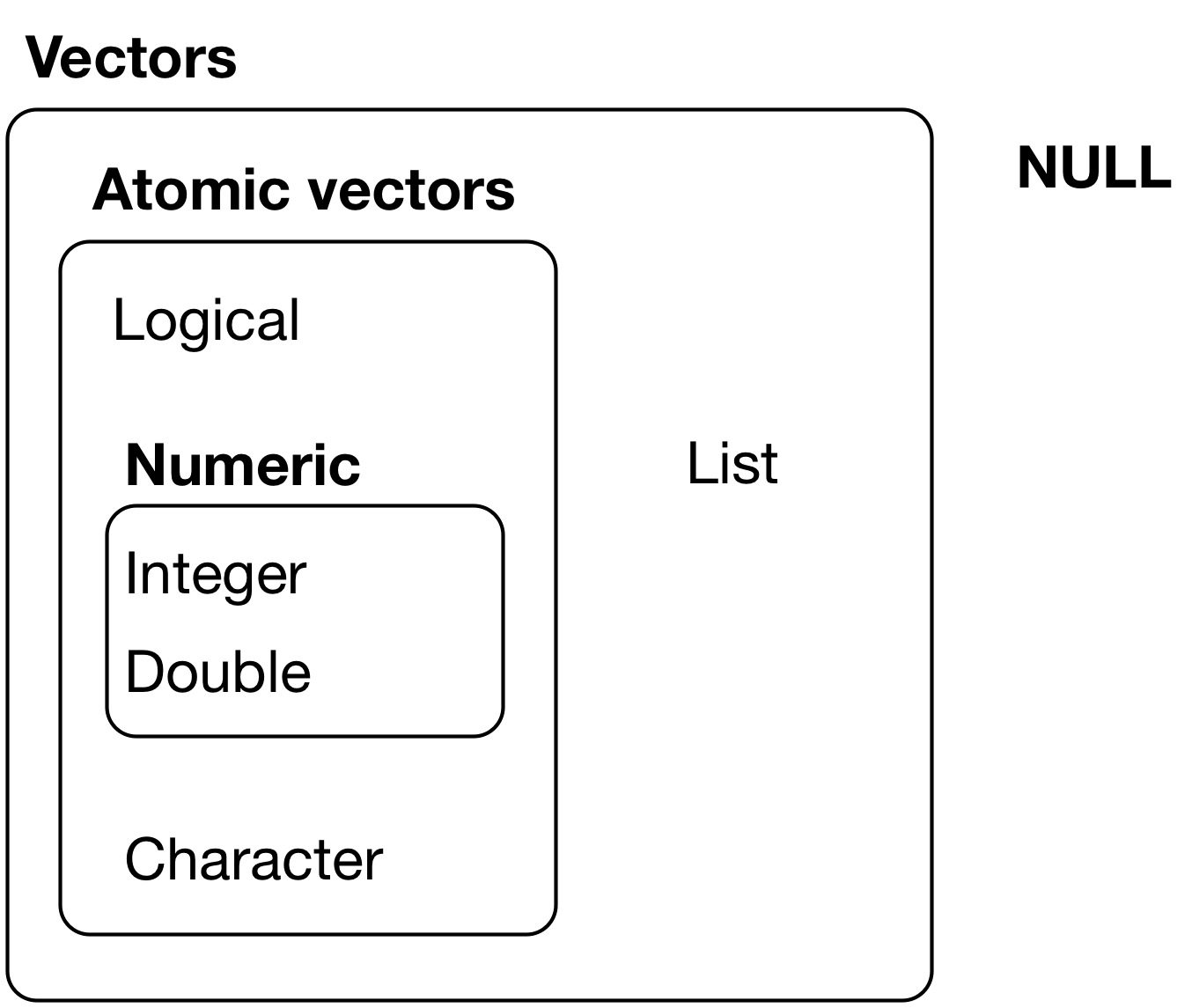(myvec1 <- c(1, 5, 3, 6))[1] 1 5 3 6(myvec2 <- c(11, 14, 18, 12))[1] 11 14 18 122023-02-06

c()
c(myvec1, myvec2)[1] 1 5 3 6 11 14 18 12c()
(myvec3 <- c("a", "b", "c"))[1] "a" "b" "c"c()
Strain your brain
What do you think will happen if you combine myvec2 and myvec3?
myvec2[1] 11 14 18 12myvec3[1] "a" "b" "c"c(myvec2, myvec3)[1] "11" "14" "18" "12" "a" "b" "c" myvec2 converts to character vector to combine with myvec3
seq()
:
4:9[1] 4 5 6 7 8 99:4[1] 9 8 7 6 5 4Try it!
Make a sequence from 0 to 100 in steps of 10.
rep()
rep(0, times = 10) [1] 0 0 0 0 0 0 0 0 0 0rep()
rep()
rep(1:4, times = 3) [1] 1 2 3 4 1 2 3 4 1 2 3 4rep(1:4, each = 3) [1] 1 1 1 2 2 2 3 3 3 4 4 4Try it!
Create a repetition of “yes” and “no” with 10 instance of each, alternating between the two. Then make one with 10 “yes” and then 10 “no”.
length()
Try it!
How long is the combined vector of myvec1 and myvec2?
typeof() and str()
[]
myvec2[1] 11 14 18 12myvec2[2][1] 14myvec2[2] <- NA
myvec2[1] 11 NA 18 12mydf <- data.frame(
datetime = as.Date(c("2021-04-21 11:56:12", "2021-04-21 14:57:44", "2021-04-22 03:09:56", "2021-04-22 12:39:22")),
session_complete = as.logical(c("TRUE", "TRUE", "TRUE", "FALSE")),
condition = as.factor(c("control", "control", "experimental", "experimental")),
mean_response = c(17.53, 24.45, 19.82, NA),
age = c(19, 20, 19, NA),
comments = c("none", "Great study", "toooo long", NA)
)mydf datetime session_complete condition mean_response age comments
1 2021-04-21 TRUE control 17.53 19 none
2 2021-04-21 TRUE control 24.45 20 Great study
3 2021-04-22 TRUE experimental 19.82 19 toooo long
4 2021-04-22 FALSE experimental NA NA <NA>typeof(mydf)[1] "list"str(mydf)'data.frame': 4 obs. of 6 variables:
$ datetime : Date, format: "2021-04-21" "2021-04-21" ...
$ session_complete: logi TRUE TRUE TRUE FALSE
$ condition : Factor w/ 2 levels "control","experimental": 1 1 2 2
$ mean_response : num 17.5 24.4 19.8 NA
$ age : num 19 20 19 NA
$ comments : chr "none" "Great study" "toooo long" NACreate new vectors
(mydf1 <- data.frame(subject = 1:3,
response = 8:6)) subject response
1 1 8
2 2 7
3 3 6Combine existing vectors
var1 <- c(1:6)
var2 <- c(6:1)
var3 <- c(21:26)
mydf2 <- data.frame(var1, var2,
resp = var3)
mydf2 var1 var2 resp
1 1 6 21
2 2 5 22
3 3 4 23
4 4 3 24
5 5 2 25
6 6 1 26[row, column]
mydf1 subject response
1 1 8
2 2 7
3 3 6mydf1[2, 1] [1] 2mydf1[2, 1] <- 6
mydf1 subject response
1 1 8
2 6 7
3 3 6[row, column]
Extract whole rows/columns
mydf1[2, ] subject response
2 6 7mydf1[, 2] [1] 8 7 6Extract subsets
mydf1[2:3, 2][1] 7 6mydf1[2:3, 1:2] subject response
2 6 7
3 3 6$
mydf1$response [1] 8 7 6mydf1$response[2] [1] 7mydf1$response[2:3] [1] 7 6Strain your brain
Why should you use column names rather than number?
head()
head(mtcars) mpg cyl disp hp drat wt qsec vs am gear carb
Mazda RX4 21.0 6 160 110 3.90 2.620 16.46 0 1 4 4
Mazda RX4 Wag 21.0 6 160 110 3.90 2.875 17.02 0 1 4 4
Datsun 710 22.8 4 108 93 3.85 2.320 18.61 1 1 4 1
Hornet 4 Drive 21.4 6 258 110 3.08 3.215 19.44 1 0 3 1
Hornet Sportabout 18.7 8 360 175 3.15 3.440 17.02 0 0 3 2
Valiant 18.1 6 225 105 2.76 3.460 20.22 1 0 3 1Note
Add the argument n = 10 to head(mtcars). What does this do?
mydf2 var1 var2 resp
1 1 6 21
2 2 5 22
3 3 4 23
4 4 3 24
5 5 2 25
6 6 1 26(mytibble <- tibble::tibble(mydf2))# A tibble: 6 × 3
var1 var2 resp
<int> <int> <int>
1 1 6 21
2 2 5 22
3 3 4 23
4 4 3 24
5 5 2 25
6 6 1 26